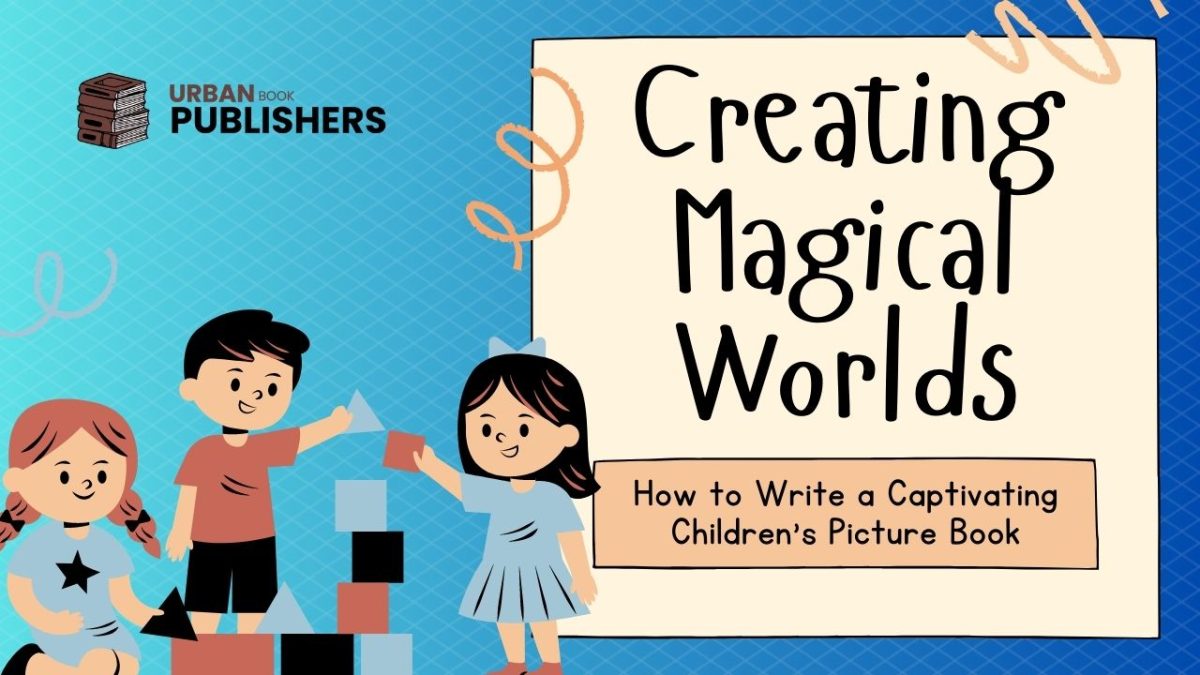
Writing
Just Press Play To Hear The Piece.
Children’s picture books can transport young readers into magical worlds filled with imagination, wonder, and adventure. As a writer, crafting such captivating stories requires careful thought and creativity. This article will explore the essential elements and techniques in creating a mesmerizing children’s picture book to delight and inspire young minds.

1. Understanding the Target Audience
The best way to create a captivating children’s picture book is to understand your target audience. This will help you create a story that engages children and gives them something they can relate to.
If you are an author looking to write a children’s picture book, you must know who you are writing for. Children have different personalities and interests, so writing a story that appeals to everyone can be challenging. However, understanding the target audience allows you to create a story that works well for most kids.
The first step in creating a captivating children’s picture book is understanding your audience. You may want to get feedback from other parents or teachers on how they see their students acting and reacting in certain situations. You could also ask them about their favorite books and why they like them. This information can help shape your storyline and characters to match your audience’s interests.
2. Developing a Captivating Premise
Developing a captivating premise… For more on crafting an engaging story, see how to start a fictional story To do this, you must ask yourself: What is my book about?
Once you have the answer to this question, you can build your story around it. Think about the kinds of characters that would fit into your story and what they would do when faced with obstacles. Do they have superpowers? If so, how will they use them?
You should also consider what kind of setting you want your book to take place in. A good start is to consider all the places important for you and your readers. Then think about whether these places could be incorporated into your story.
3. Crafting Engaging Characters
When creating characters… For character development tips, refer to how might a book publisher use blogs in its marketing research efforts Some writers have their characters fully fleshed out before they begin writing, while others discover their characters as they go.
One of the most important things you can do when creating a character is to give them an emotional arc. This means that your character starts feeling one way and ends up feeling another. An easy way to do this is by changing your character’s attitude throughout your story. For example, if your main character is mean at the story’s beginning but then learns to be kind by the end, you’ve given them an emotional arc!
4. Building a Vibrant Setting
Here are some tips for building a vibrant setting… Additionally, check out formatting tips for a children’s book layout for more ideas.
- Start with an engaging concept.
- Create a mood board to help you visualize your setting.
- Map out the physical location of your story in detail, including major landmarks and how they’re connected (and to your characters).
- Choose specific details that complement each other and create a feeling of unity throughout the story’s world.
5. Employing Descriptive Language
You must employ descriptive language to create a magical world in your children’s picture book. This not only helps readers to visualize the world you’re creating, but it also helps them to feel like they are there.
Descriptive language can be used in several ways:
- It can be used as an adjective or adverb to describe characters or objects. For example, “The little girl was wearing a bright red dress.”
- It can describe actions that take place in the story. For example, “The little girl skipped across the lawn.”
- It can set the story’s mood and create an atmosphere for readers by describing what things look or sound like. For example, “The wind whistled through the trees as she walked through town.”
6. Incorporating Interactive Elements
Include engaging parts… Learn more about interactive storytelling in the power of publishing an eBook. This could include pages with flaps you can lift, textures you can touch and feel, or secret surprises. Interactive features make reading fun and encourage kids to actively participate in the story.
7. Trying to keep things simple
Even if your story occurs in a magical world… For simplifying complex ideas, see which two factors combine to form an author’s purpose for writing a text. and easy for young readers to understand is important. Use words and sentence patterns that are right for your age. To keep things clear, break complex thoughts into parts that are easy to understand.
8. Getting the right mix of text and pictures
The words and pictures… For more on this synergy, refer to how to write and publish a scientific paper. Make sure that the two are in balance with each other. Use the words to show important facts and feelings, and let the pictures add to the story’s visual appeal and give more information.
9. Making sure the ending is memorable
A captivating children’s picture book must have a good finish. See how to writing a book report for tips on creating memorable endings. Tie up lost ends, say something important, or give a feeling of closure. Leave a lasting impact on young readers and make them want to return to the magical world you’ve created.
10. Editing and Polishing
After you finish your first draft, carefully review and edit your manuscript. Polish the language, get rid of things that aren’t important, and make sure the story flows well. Pay attention to the pace, conversation, and characters’ growth. Think about asking other writers or workers in the field for feedback. You can take help from professional services like urban book publishers in new york to get the best editing of your book.
11. Promoting and Publishing
After you’ve fixed up your work… For publishing insights, read about publishing for young minds how to publish a children’s book on Amazon. Find publishers that focus on picture books for kids and send your work to them following their rules. You should also build an online presence through social media, author websites, and partnerships with illustrators or book bloggers to successfully promote your book.
Main Element and Elaborate Information
| Element | Description | Examples/Ideas |
|---|---|---|
| Audience Insight | Understanding the interests and developmental stages of the target age group. | Surveys from parents/teachers, popular themes in current children’s books. |
| Story Foundation | Building a unique and engaging storyline or concept. | Adventures in a mythical forest, solving a mystery in a magical city. |
| Character Development | Creating relatable and dynamic characters with depth. | A young explorer with a passion for nature, a curious inventor with imaginative gadgets. |
| Setting & World-Building | Crafting a vivid and immersive world for the characters. | Detailed map of a fantastical island, a city where every building tells a story. |
| Language & Expression | Using descriptive and age-appropriate language to enhance storytelling. | Rich adjectives for scenery, simple yet expressive dialogue. |
| Interactive Features | Incorporating elements that engage the reader directly. | Flaps to reveal hidden details, textures for sensory experience. |
| Simplicity & Balance | Balancing simplicity in storytelling with engaging content. | Simple plot with a twist, balanced narrative and illustrations. |
Conclusion
Crafting a captivating children’s picture book is an enchanting journey that allows you to ignite the imagination of young readers. By understanding your target audience, developing a captivating premise, creating engaging characters, and employing descriptive language, you can create a magical world that leaves a lasting impact on children’s lives. Remember to edit and polish your manuscript, promote your book effectively, and explore publishing options to share your creation with the world.




